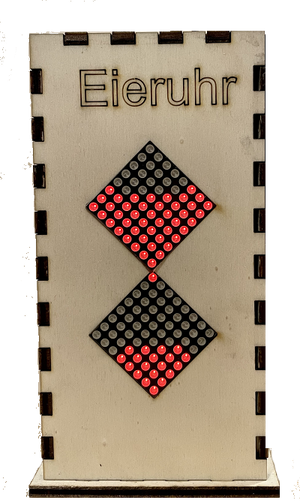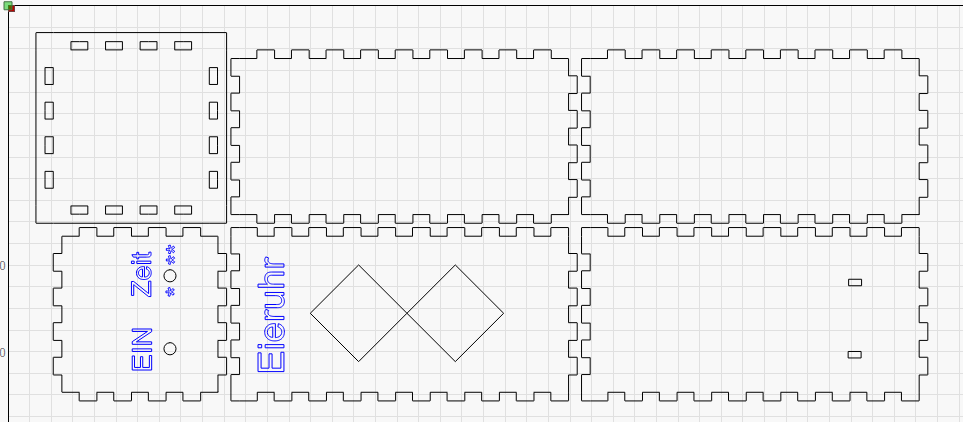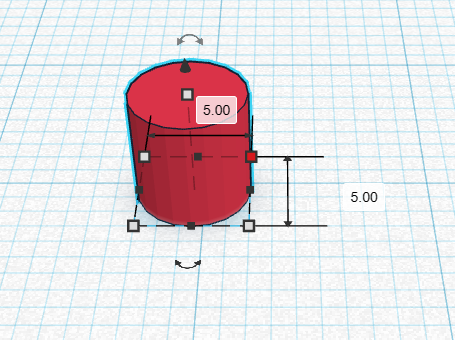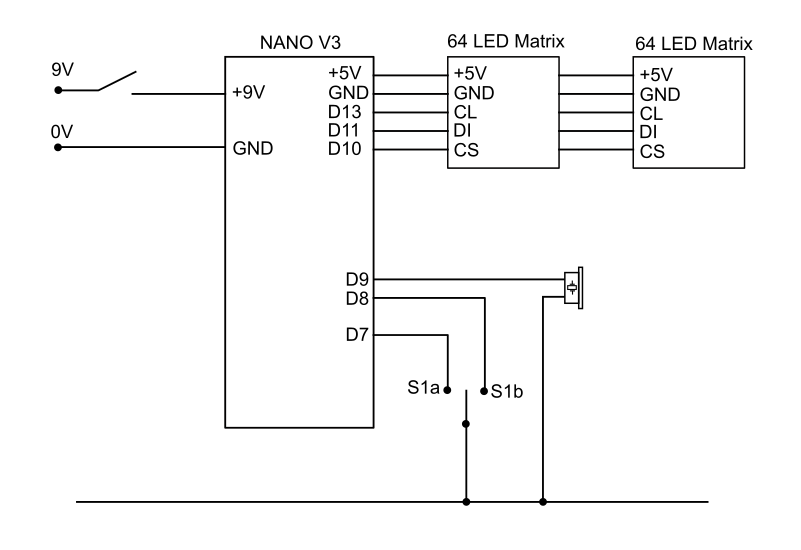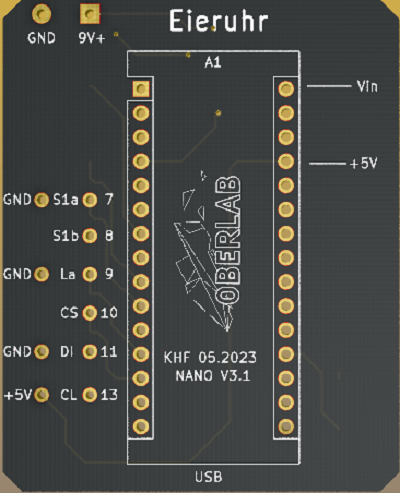Eieruhr - Montage Anleitung
Mit diesem Projekt wird eine Eieruhr mit zwei 64LED-Matrix-Modulen realisiert. Schalter 1 ist der Einschalter und mit Schalter 2 kann zwischen 3 Zeiten gewählt werden, 5 Minuten, 5 Minuten 30 Sekunden und 6 Minuten. Beim Einschalten ertönen, je nach gewählter Zeit, unterschiedliche Signale. Zusätzlich wird bei gewählten 5,5 Minuten zusätzlich ein Signal bei abgelaufenen 5 Minuten, bei gewählten 6 Minuten ein Signal bei 5 und 5,5 Minuten ausgegeben. Diese Zeiten können softwareseitig in nachfolgender Zeile verändert werden:
int pause_5 = 136; int pause_5_5 = 149; int pause_6 = 162;
Die Zeiten für die Zwischensignale in der Zeile:
byte beep_1 = 50; byte beep_2 = 44; byte beep_3 = 50;
Beide Zeilen befinden sich im Deklarationsteil des Sketches.
Hardware
Die Stückliste für die Eieruhr
- 1 x NANO
- 1 x NANO-Shield
- 2 x Buchsenleisten
- 2 x Stiftleisten
- 1 x LM2536
- 2 x 64 LED Matrix Module
- 1 x Buzzer
- 1 x Wechselschalter
- 1 x Schalter 1pol.
- 1 x 9V Batterieclip
- 1 x 9V Batterie
- 1 x Gelasertes Gehäuse (4mm Sperrholz 600x300)
Aufbau und Montage
Der Aufbau und die Montage der Eieruhr ist in mehrere Schritte unterteilt.
Schritt 1: Das Gehäuse
Erstelle auf Boxes.PY eine "BasedBox" mit den Abmessungen x=88, y=88 und h=160.
Füge in die erstellte SVG-Grafik die Ausschnitte für die LED Matrix und die Schalter ein
Füge in die erstellte SVG-Grafik den Text "Eieruhr, Ein und Zeit" ein
Schneide das Gehäuse mit dem Lasercutter aus
Montiere die Bauteile an das Gehäuse
Verklebe die Gehäuseteile. Die untere Rückwand wird nicht verklebt
Schritt 2: 3D-Druck
Zeichne und drucke 8 Platinen Füße für den NANO und das Step-Down-Modul, D=5mm x 5mm
Klebe die Füße auf die Unterseite des NANO-Shields und des Step-Down-Moduls
Schritt 3: Verdrahtung und Lötarbeiten
Bestücke das NANO-Shield mit den Buchsenleisten
Verdrahte das Shield, die LED Matrix, Schalter und den Buzzer nach den Verdrahtungsplan
Schritt 4: Inbetriebnahme
- Stelle das Step-Down-Modul auf 5V Ausgangsspannung ein
- Kontrolliere alle Verbindungen
Lade das LED-Matrix-Test Programm in den NANO
Versorge die Eieriuhr mit Spannung
Teste die Funktion
Wenn die Funktion der LED Matrix ok ist, lade das Haupt-Programm in den NANO
Das Programm befindet sich auf deinen Laptop unter Nextcloud/Eieruhr
Teste die Funktion
LED Matrix - Text Programm
/*************************************************************************************************
PROGRAMMINFO
**************************************************************************************************
Funktion: 64-LED-Matrix-Screen-Modul - Testprogramm
**************************************************************************************************
Version: 23.02.2022
**************************************************************************************************
Board: NANO V3
**************************************************************************************************
C++ Arduino IDE V1.8.13
**************************************************************************************************
Einstellungen:
https://dl.espressif.com/dl/package_esp32_index.json
http://dan.drown.org/stm32duino/package_STM32duino_index.json
https://raw.githubusercontent.com/espressif/arduino-esp32/gh-pages/package_esp32_dev_index.json
**************************************************************************************************
Librarys
- WiFi.h V0.16.1
**************************************************************************************************
**************************************************************************************************/
#include <MD_MAX72xx.h >
#define HARDWARE_TYPE MD_MAX72XX::FC16_HW
#define MAX_DEVICES 1
#define CLK_PIN 13 // or SCK
#define DATA_PIN 11 // or MOSI
#define CS_PIN 10 // or SS
#define DELAYTIME 100 // in milliseconds
MD_MAX72XX mx = MD_MAX72XX(HARDWARE_TYPE, CS_PIN, MAX_DEVICES);
void scrollText(char *p) {
uint8_t charWidth;
uint8_t cBuf[8];
mx.clear();
while (*p != '\0') {
charWidth = mx.getChar(*p++, sizeof(cBuf) / sizeof(cBuf[0]), cBuf);
for (uint8_t i=0; i<=charWidth; i++) {
mx.transform(MD_MAX72XX::TSL);
if (i < charWidth) {
mx.setColumn(0, cBuf[i]);
}
delay(DELAYTIME);
}
}
}
void rows() {
mx.clear();
for (uint8_t row=0; row<ROW_SIZE; row++) {
mx.setRow(row, 0xff);
delay(2*DELAYTIME);
mx.setRow(row, 0x00);
}
}
void columns() {
mx.clear();
for (uint8_t col=0; col<mx.getColumnCount(); col++) {
mx.setColumn(col, 0xff);
delay(DELAYTIME/MAX_DEVICES);
mx.setColumn(col, 0x00);
}
}
void intensity() {
uint8_t row;
mx.clear();
for (int8_t i=0; i<=MAX_INTENSITY; i++) {
mx.control(MD_MAX72XX::INTENSITY, i);
mx.setRow(0, 0xff);
delay(DELAYTIME*10);
}
mx.control(MD_MAX72XX::INTENSITY, 8);
}
void transformation() {
uint8_t arrow[COL_SIZE] = {
0b00001000,
0b00011100,
0b00111110,
0b01111111,
0b00011100,
0b00011100,
0b00111110,
0b00000000 };
MD_MAX72XX::transformType_t
t[] = {
MD_MAX72XX::TSL, MD_MAX72XX::TSL, MD_MAX72XX::TSL, MD_MAX72XX::TSL,
MD_MAX72XX::TSL, MD_MAX72XX::TSL, MD_MAX72XX::TSL, MD_MAX72XX::TSL,
MD_MAX72XX::TSL, MD_MAX72XX::TSL, MD_MAX72XX::TSL, MD_MAX72XX::TSL,
MD_MAX72XX::TSL, MD_MAX72XX::TSL, MD_MAX72XX::TSL, MD_MAX72XX::TSL,
MD_MAX72XX::TFLR,
MD_MAX72XX::TSR, MD_MAX72XX::TSR, MD_MAX72XX::TSR, MD_MAX72XX::TSR,
MD_MAX72XX::TSR, MD_MAX72XX::TSR, MD_MAX72XX::TSR, MD_MAX72XX::TSR,
MD_MAX72XX::TSR, MD_MAX72XX::TSR, MD_MAX72XX::TSR, MD_MAX72XX::TSR,
MD_MAX72XX::TSR, MD_MAX72XX::TSR, MD_MAX72XX::TSR, MD_MAX72XX::TSR,
MD_MAX72XX::TRC,
MD_MAX72XX::TSD, MD_MAX72XX::TSD, MD_MAX72XX::TSD, MD_MAX72XX::TSD,
MD_MAX72XX::TSD, MD_MAX72XX::TSD, MD_MAX72XX::TSD, MD_MAX72XX::TSD,
MD_MAX72XX::TFUD,
MD_MAX72XX::TSU, MD_MAX72XX::TSU, MD_MAX72XX::TSU, MD_MAX72XX::TSU,
MD_MAX72XX::TSU, MD_MAX72XX::TSU, MD_MAX72XX::TSU, MD_MAX72XX::TSU,
MD_MAX72XX::TINV,
MD_MAX72XX::TRC, MD_MAX72XX::TRC, MD_MAX72XX::TRC, MD_MAX72XX::TRC,
MD_MAX72XX::TINV };
mx.clear();
mx.control(MD_MAX72XX::UPDATE, MD_MAX72XX::OFF);
for (uint8_t j=0; j<mx.getDeviceCount(); j++) {
mx.setBuffer(((j+1)*COL_SIZE)-1, COL_SIZE, arrow);
}
// one tab
mx.control(MD_MAX72XX::UPDATE, MD_MAX72XX::ON);
delay(DELAYTIME);
mx.control(MD_MAX72XX::WRAPAROUND, MD_MAX72XX::ON);
for (uint8_t i=0; i<(sizeof(t)/sizeof(t[0])); i++) {
mx.transform(t[i]);
delay(DELAYTIME*4);
}
mx.control(MD_MAX72XX::WRAPAROUND, MD_MAX72XX::OFF);
}
void showCharset() {
mx.clear();
mx.update(MD_MAX72XX::OFF);
for (uint16_t i=0; i<256; i++) {
mx.clear(0);
mx.setChar(COL_SIZE-1, i);
if (MAX_DEVICES >= 3) {
char hex[3];
sprintf(hex, "%02X", i);
mx.clear(1);
mx.setChar((2*COL_SIZE)-1, hex[1]);
mx.clear(2);
mx.setChar((3*COL_SIZE)-1, hex[0]);
}
mx.update();
delay(DELAYTIME*2);
}
mx.update(MD_MAX72XX::ON);
}
void setup() {
mx.begin();
}
void loop() {
scrollText("Graphics");
rows();
columns();
intensity();
transformation();
showCharset();
delay(3000);
}Fertig!

